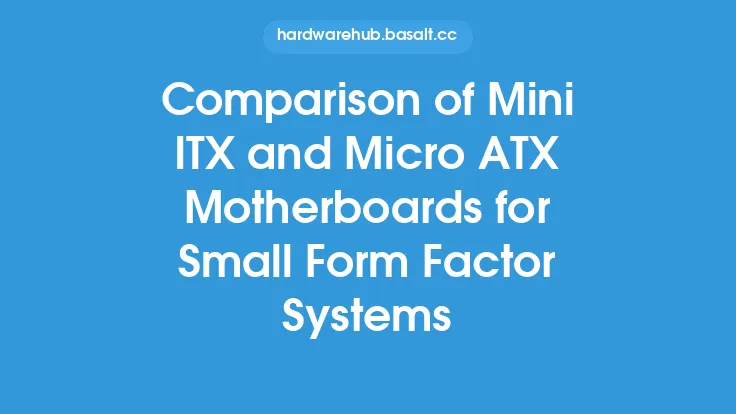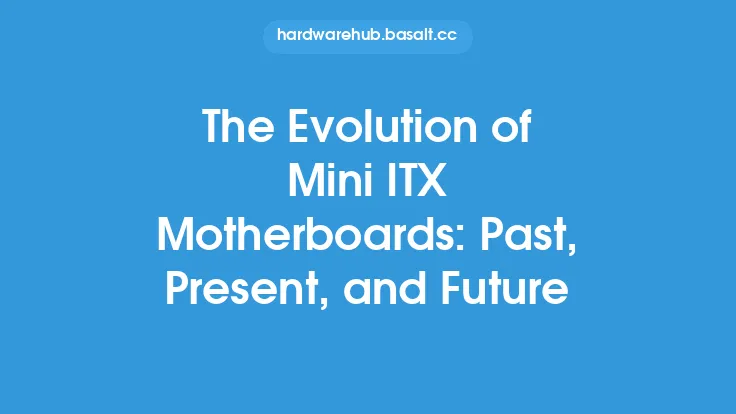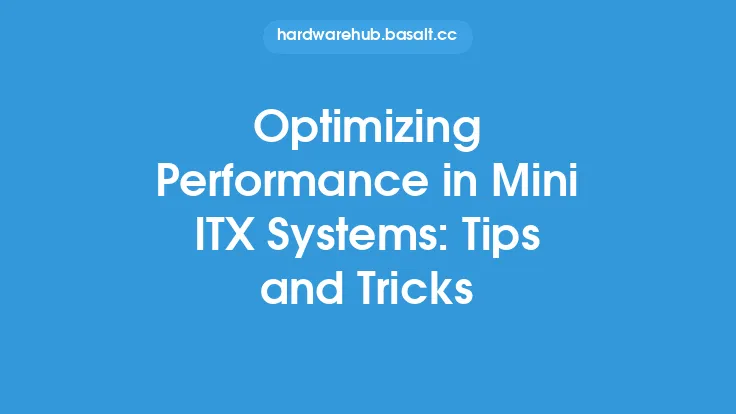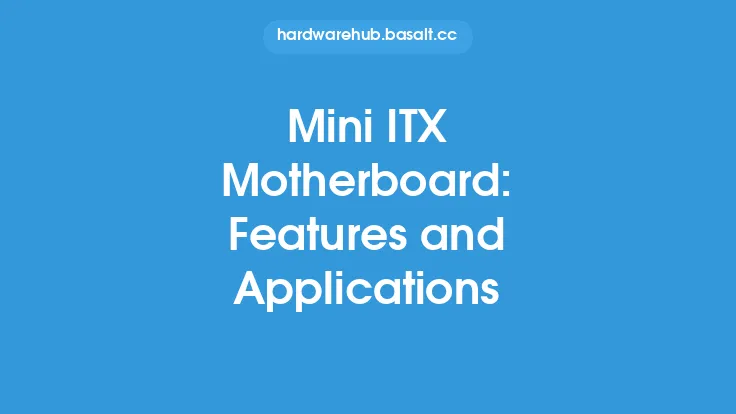The use of Mini ITX motherboards in industrial and embedded systems has become increasingly popular due to their compact size, low power consumption, and high performance. These motherboards are designed to provide a reliable and efficient platform for a wide range of applications, from industrial control systems to medical devices and transportation systems. In this article, we will explore the benefits and applications of using Mini ITX motherboards in industrial and embedded systems, as well as the key considerations and challenges that come with designing and implementing these systems.
Introduction to Mini ITX Motherboards
Mini ITX motherboards are a type of small form factor (SFF) motherboard that measures 6.7 inches by 6.7 inches (17 cm x 17 cm). They are designed to be compact and energy-efficient, making them ideal for use in industrial and embedded systems where space and power are limited. Mini ITX motherboards typically feature a range of connectors and interfaces, including USB, Ethernet, and SATA, as well as support for various operating systems and software applications.
Benefits of Mini ITX Motherboards in Industrial and Embedded Systems
The use of Mini ITX motherboards in industrial and embedded systems offers a number of benefits, including:
- Compact size: Mini ITX motherboards are designed to be small and compact, making them ideal for use in applications where space is limited.
- Low power consumption: Mini ITX motherboards are designed to be energy-efficient, which reduces the overall power consumption of the system and minimizes heat generation.
- High performance: Mini ITX motherboards are capable of delivering high performance and reliability, making them suitable for use in demanding industrial and embedded applications.
- Cost-effectiveness: Mini ITX motherboards are often less expensive than larger motherboards, which makes them a cost-effective option for industrial and embedded systems.
- Flexibility: Mini ITX motherboards are available with a range of connectors and interfaces, making them suitable for use in a wide range of applications.
Applications of Mini ITX Motherboards in Industrial and Embedded Systems
Mini ITX motherboards are used in a wide range of industrial and embedded applications, including:
- Industrial control systems: Mini ITX motherboards are used in industrial control systems to provide a reliable and efficient platform for controlling and monitoring industrial processes.
- Medical devices: Mini ITX motherboards are used in medical devices, such as patient monitoring systems and medical imaging equipment, to provide a compact and reliable platform for processing and displaying medical data.
- Transportation systems: Mini ITX motherboards are used in transportation systems, such as traffic management systems and railway control systems, to provide a reliable and efficient platform for controlling and monitoring transportation infrastructure.
- Aerospace and defense: Mini ITX motherboards are used in aerospace and defense applications, such as navigation systems and communication equipment, to provide a compact and reliable platform for processing and transmitting critical data.
Key Considerations for Designing and Implementing Mini ITX Motherboards in Industrial and Embedded Systems
When designing and implementing Mini ITX motherboards in industrial and embedded systems, there are several key considerations to keep in mind, including:
- Environmental factors: Mini ITX motherboards must be designed to operate in a range of environmental conditions, including extreme temperatures, humidity, and vibration.
- Power supply: Mini ITX motherboards require a reliable and efficient power supply to ensure stable operation and minimize power consumption.
- Cooling: Mini ITX motherboards must be designed to dissipate heat effectively, which can be a challenge in compact systems.
- Connectivity: Mini ITX motherboards must be designed to provide a range of connectors and interfaces to support various peripherals and devices.
- Software support: Mini ITX motherboards must be designed to support a range of operating systems and software applications, including real-time operating systems and device drivers.
Technical Considerations for Mini ITX Motherboards in Industrial and Embedded Systems
When designing and implementing Mini ITX motherboards in industrial and embedded systems, there are several technical considerations to keep in mind, including:
- Processor selection: The choice of processor will depend on the specific requirements of the application, including performance, power consumption, and thermal characteristics.
- Memory and storage: The selection of memory and storage devices will depend on the specific requirements of the application, including capacity, speed, and reliability.
- I/O interfaces: The selection of I/O interfaces will depend on the specific requirements of the application, including USB, Ethernet, and SATA.
- Power management: The design of the power management system will depend on the specific requirements of the application, including power consumption, voltage regulation, and thermal characteristics.
- Thermal management: The design of the thermal management system will depend on the specific requirements of the application, including heat dissipation, airflow, and thermal interfaces.
Conclusion
In conclusion, Mini ITX motherboards are a popular choice for industrial and embedded systems due to their compact size, low power consumption, and high performance. They offer a range of benefits, including cost-effectiveness, flexibility, and reliability, making them suitable for use in a wide range of applications. However, when designing and implementing Mini ITX motherboards in industrial and embedded systems, there are several key considerations to keep in mind, including environmental factors, power supply, cooling, connectivity, and software support. By understanding these considerations and selecting the right Mini ITX motherboard for the specific application, designers and engineers can create reliable and efficient industrial and embedded systems that meet the demands of modern applications.





